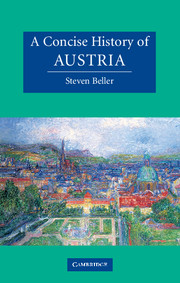Book contents
- Frontmatter
- Contents
- List of illustrations
- List of maps
- Acknowledgements
- Map 1 The Austrian Republic, 2006
- Introduction
- 1 The Eastern March, to 1439
- 2 AEIOU, 1439–1740
- 3 Countering reform, 1740–1866
- 4 Empire on notice, 1866–1918
- 5 The land without qualities, 1918–1945
- 6 Austria Inc., from 1945
- Conclusion
- Guide to further reading
- Index
- CAMBRIDGE CONCISE HISTORIES
6 - Austria Inc., from 1945
Published online by Cambridge University Press: 05 June 2014
- Frontmatter
- Contents
- List of illustrations
- List of maps
- Acknowledgements
- Map 1 The Austrian Republic, 2006
- Introduction
- 1 The Eastern March, to 1439
- 2 AEIOU, 1439–1740
- 3 Countering reform, 1740–1866
- 4 Empire on notice, 1866–1918
- 5 The land without qualities, 1918–1945
- 6 Austria Inc., from 1945
- Conclusion
- Guide to further reading
- Index
- CAMBRIDGE CONCISE HISTORIES
Summary
When the Republic of Austria was proclaimed restored on 27 April 1945 its land and people were in a state of utter disaster and moral degradation. Austrian participation in the Third Reich had had as its reward only physical, economic, moral and political ruin. Sixty years later, Austria is one of the world's most prosperous and secure countries. In 2006 it (again) held the presidency of the European Union. The phoenix-like rise of the Austrian Second Republic from the ashes of 1945 has been one of the most remarkable success stories of post-war Europe.
This transformation has not been without its setbacks, and some potentially tragic flaws. The economic prosperity and political cohesion of the Second Republic, so sorely missing in the First, were made possible partly by a socio-political pact that led to political stagnation, and partly by a conspiratorial manipulation of the Austrian past. This abuse of history helped cement Austrian national identity, at the expense of Austrian self-understanding. Austrians today are still living with the unsettling consequences.
BREAKING FREE, 1945–1955
In the chaotic days of May 1945, as American troops were invading Upper Austria, a teenage girl in Leonfelden heard a rap at the front door. She went to open the door, but on seeing an African-American GI, she was so shocked at his black face that she slammed the door shut and ran back upstairs. Nazi indoctrination and cultural prejudice made this reaction virtually inevitable.
- Type
- Chapter
- Information
- A Concise History of Austria , pp. 249 - 310Publisher: Cambridge University PressPrint publication year: 2007



